The big caddis hatch everyone can't wait for is the Mothers Day Caddis or Brachycentrus. The Brachycentrus is a cased caddis that lives in just about every stream. This is a prolific hatch and trout engorge themselves on this abundant insects. This hatch in the east starts in May around Mothers Day and can go well in to June, making it an important hatch to fishers.
There are many outstanding patterns to imitate the pupa (it's most vulnerable stage). The best well know is
LaFontaine’s Sparkle Pupa. Again I'd like to point you in the direction of Matt Grobert's video
Tying the LaFontaine Sparkle Emerger produced by Tim Flagler aka
Tightline Productions for instruction on tying this classic pattern. Another notable pattern is
Barr’s Graphic Caddis.
My take on the Mothers Day Caddis is simple, like most of my patterns, mainly because I want to spend more time fishing than tying (the real reason is I'm lazy). With most of the patterns I develop the golden rule is Keep it simple, Stupid. For those who don't know the K.I.S.S. rule it's attributed to Kelly Johnson, lead engineer at the Lockheed Skunk Works think spy planes Lockheed U-2 and SR-71 Blackbird.
This patterns is developed from observation. I always have a small seine net and will do a kick sample of the stream I fishing to see what bugs and numbers. If you look at my
Popular Posts you'll see that "
Emerging Caddis Pupa" is one of my most popular post and those are the images and video I used as reference.
I must give inspirational credit to
Davie McPhail videos where I pick-upped using Flashabou for the rib and tinting it with a permanent marker to create a darker but flashy rib.
 |
Bubble Pupa |
Hook: Light Wire Caddis Hook.
Size: 14 - 16
Thread: Brown 6/0 or 8/0
Tag: Flashabou
Rib: Flashabou tinted with olive permanent marker.
Abdomen: Hareline Dubbin HD13 (Insect Green)
Gas Bubble: 1/8" Micro Foam (used to protect electronic)
Legs: Hungarian Partridge
Thorax: Brown Squirrel Dubbing
 |
| Start thread and tie in Flashabou. |
 |
| Wrap tag tie off and dub abdomen. |
 |
| Tint the inside of the Flashabou and rib abdomen. |
 |
| Tie in micro foam 1/8" wide. |
 |
| Tie in Hungarian Partridge by tip. |
 |
| Wind Partridge tie off and fold over wing case. |
 |
| Dub Thorax and whip finish. |
 |
| Your finished Bubble Pupa. |
This pattern is a impressionistic pupa designed to be fished in the film. The micro packing foam helps it float and allows light to pass through to mimic the gas bubble of the pupa. Hence the name Bubble Pupa. This pattern can be tied in various colors to match the caddis coming off on your stream.
















